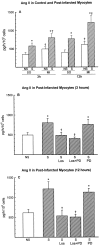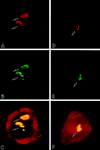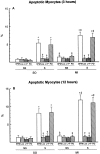Up-regulation of AT(1) and AT(2) receptors in postinfarcted hypertrophied myocytes and stretch-mediated apoptotic cell death
- PMID: 10793077
- PMCID: PMC1876940
- DOI: 10.1016/S0002-9440(10)65037-7
Up-regulation of AT(1) and AT(2) receptors in postinfarcted hypertrophied myocytes and stretch-mediated apoptotic cell death
Abstract
To determine whether up-regulation of AT(1) and AT(2) receptors occurred in hypertrophied myocytes after infarction and whether AT(2) played a role in stretch-mediated apoptosis, left ventricular myocytes were dissociated from the surviving portion of the wall 8 days after coronary occlusion and cardiac failure in rats. Control cells were obtained from sham-operated animals. Myocytes were stretched in an equibiaxial stretch apparatus and angiotensin II (Ang II) formation and cell death were measured 3 and 12 hours later. AT(1) and AT(2) proteins were evaluated in freshly isolated myocytes and after stretch. The effects of AT(1) and AT(2) antagonists on stretch-induced Ang II synthesis and apoptosis were also established. Myocardial infarction increased AT(1) and AT(2) in myocytes and stretch further up-regulated these receptors. Ang II levels were higher in postinfarcted myocytes and this peptide increased with the duration of stretch in both groups of cells. Similarly, apoptosis increased with time in control and postinfarcted myocytes. Absolute values of Ang II and apoptosis were greater in myocytes from infarcted hearts at 3 and 12 hours after stretch. Addition of AT(1) blocker to cultures inhibited stretch-activated apoptosis in both myocyte populations as well as the generation of Ang II in postinfarcted myocytes. In contrast, AT(2) antagonists had no impact on these cellular events. In conclusion, Ang II stimulated cell death through AT(1) receptor activation, whereas ligand binding to AT(2) receptor did not alter Ang II concentration and apoptosis in normal and postinfarcted hypertrophied myocytes.
Figures







References
-
- Pfeffer MA, Braunwald E: Ventricular remodeling after myocardial infarction: experimental observations and clinical implications. Circulation 1990, 81:1161-1172 - PubMed
-
- Pfeffer MA, Braunwald E, Moyé LA, Basta L, Jr, Brown EJ, Cuddy TE, Davis BR, Geltman EM, Goldman S, Flaker GC, Klein M, Lamas GA, Packer M, Rouleau J, Rouleau JL, Rutherford J, Wertheimer JH, Hawkins CM, : on behalf of the SAVE Investigators: Effect of captropril on mortality and morbidity in patients with left ventricular dysfunction after myocardial infarction. N Engl J Med 1992, 327:669-677 - PubMed
-
- Olivetti G, Quaini F, Sala R, Lagrasta C, Corradi D, Bonacina E, Gambert SR, Cigola E, Anversa P: Acute myocardial infarction in humans is associated with activation of programmed myocyte cell death in the surviving portion of the heart. J Mol Cell Cardiol 1996, 28:2005-2016 - PubMed
-
- Narula J, Haider N, Virmani R, DiSalvo TG, Kolodgie FD, Hajjar RJ, Schmidt U, Semigran MJ, Dec GW, Khaw BA: Apoptosis in myocytes in end-stage heart failure. N Engl J Med 1996, 335:1182-1189 - PubMed
Publication types
MeSH terms
Substances
Grants and funding
LinkOut - more resources
Full Text Sources
Medical
Research Materials
Miscellaneous

